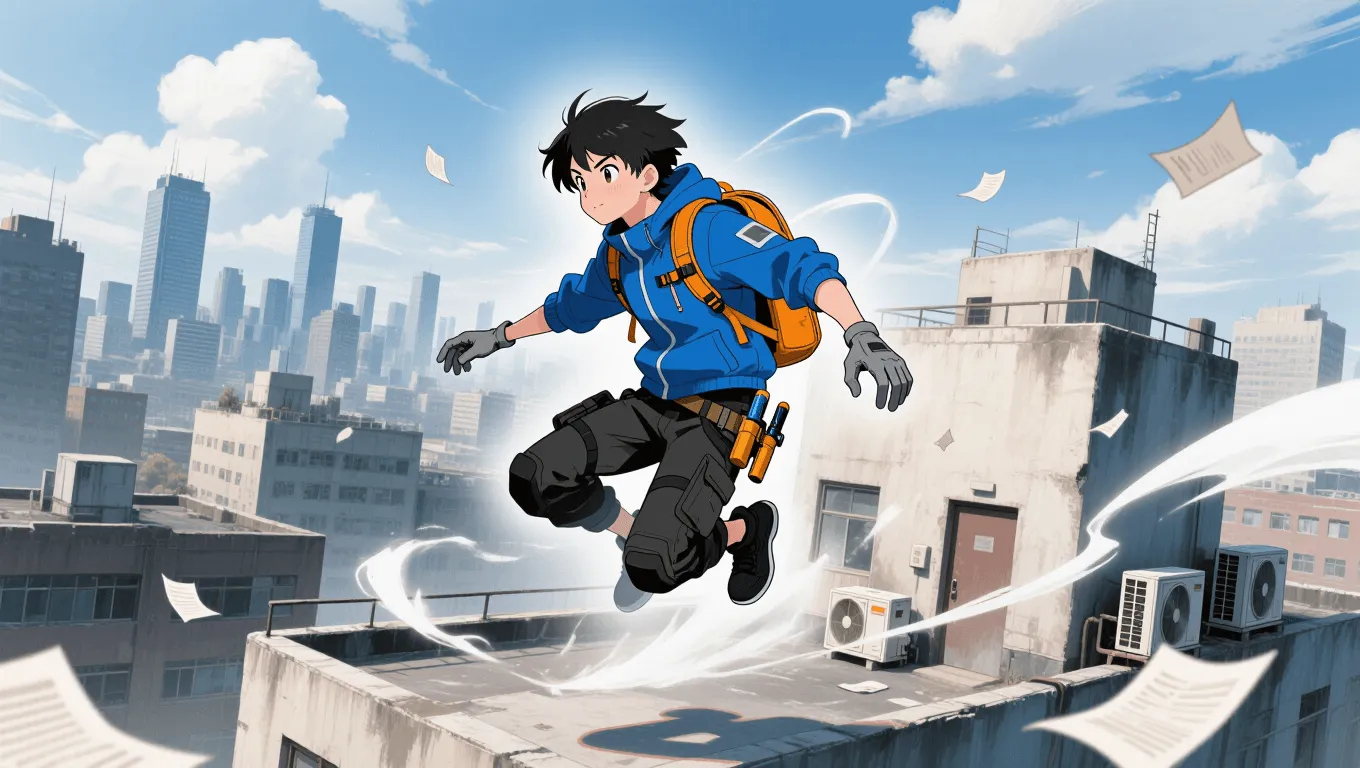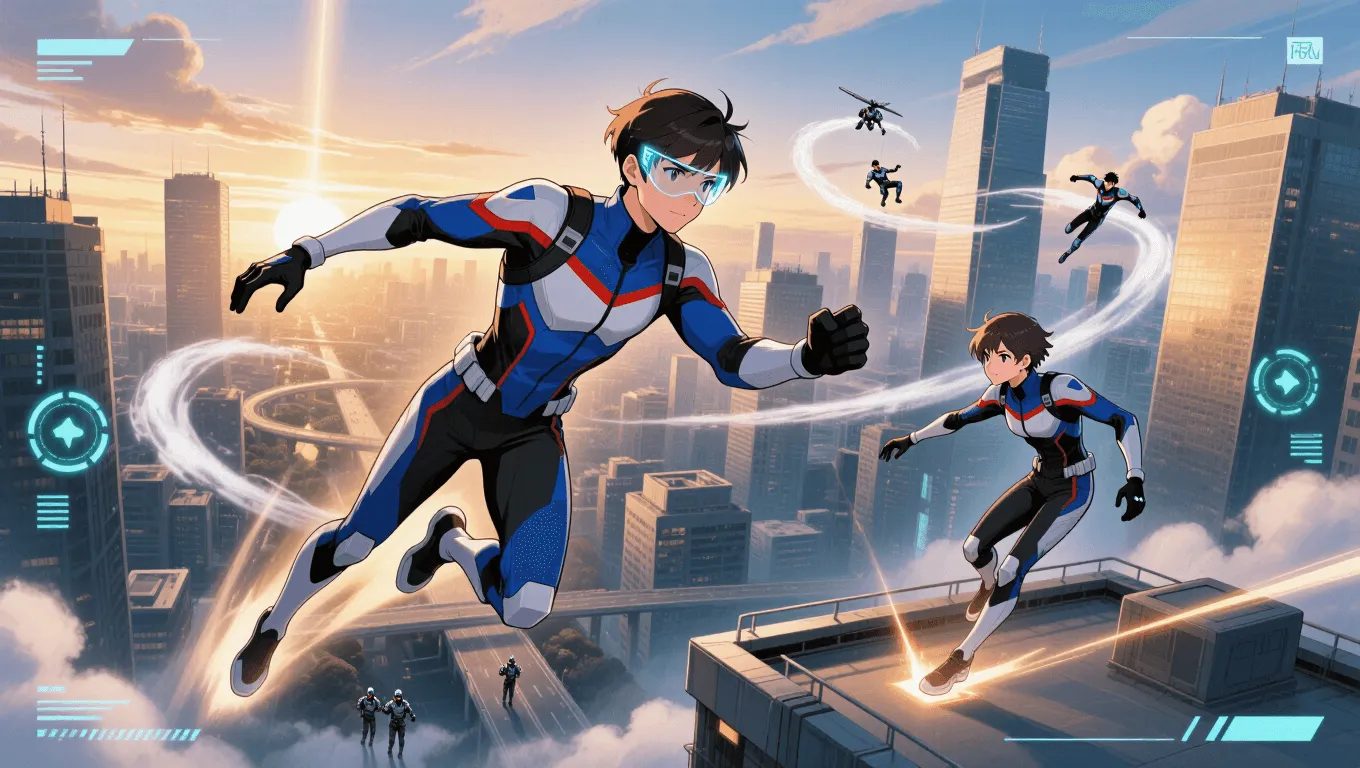Flight Superpower Explained

Flight Video Demo 🎬
Table of Contents
The flight superpower lets a character lift off the ground, hover, and travel through the air with precision and speed. Flight removes normal terrain limits, opening up vertical movement, rapid travel, and aerial combat. As one of the most recognizable powers in fiction, flight appears across myths, comics, games, and films—and often serves as a foundation for patrol, rescue, and reconnaissance. If you’re mapping out a character’s abilities, you can compare flight with hundreds of other powers in our superpower wiki or spark ideas using the random superpower generator.
What Is Flight
Flight is the supernatural or technological ability to achieve self-propelled airborne movement without conventional aircraft. Depending on origin, it may arise from anti-gravity fields, psionic levitation, elemental control of air, magnetism, bio-energy thrust, or gear such as jet boots. Regardless of source, true flight differs from gliding: the user can gain altitude, maintain speed without thermal currents, and change direction midair. At advanced levels, a flyer may reach supersonic velocities, operate in thin atmosphere, or perform stationary hovering with centimeter-level control.
Common related terms and subtypes include levitation, aerial maneuverability, VTOL-style lift-offs, drag reduction, aerodynamic shielding, momentum control, and high-altitude traversal. Writers often pair flight with speed, durability, or enhanced vision to make skyborne action feel believable.
Core Abilities of Flight
-
Takeoff and Hovering: Smooth vertical lift, gentle landings, and steady hover for observation or targeting.
-
Aerial Maneuvers: Rolls, banks, stalls, rapid stops, and tight turns; “vector control” for pinpoint direction changes.
-
Speed Scaling: From jogging pace to hypersonic sprint; advanced users can modulate acceleration to avoid G-force shock.
-
Altitude Range: Low-altitude street-level movement up to cloud tops; elite flyers reach near-space or orbital paths.
-
Environmental Compensation: Resistance to wind shear, chill, precipitation, and variable air density through body adaptation, kinetic fields, or energy auras.
-
Payload Capacity: Carrying passengers or gear; trained users learn optimal “carry posture” for lift efficiency.
-
Precision Positioning: Holding position above moving targets, threading urban canyons, or flying indoors without turbulence ricochet.
-
Emergency Utility: Evacuation, aerial searchlight sweeps, rapid delivery of medical supplies, and line-of-sight scouting.
Application / Tactical Advantages in Combat
-
Vertical Dominance: Controlling the high ground frustrates melee fighters and ground vehicles; rooftops and open sky become safe lanes.
-
Hit-and-Fade Strikes: Dive attacks, drive-by disarms, or ranged bursts from beyond typical counterattack range.
-
Battlefield Intelligence: Aerial vantage exposes flanking maneuvers and chokepoints; quick map-to-ground checks improve team calls.
-
Crowd and Hazard Control: Guiding enemies toward clear zones, towing hazards upward, or relocating explosives to safe altitude.
-
Kiting and Spacing: Flyers define engagement distance, forcing slower foes into stamina drains or risky pursuits.
-
Rescue Priority: Extracting allies from collapsing structures, floods, or firelines; delivering airborne first aid.
-
Air Superiority Chains: Pairing flight with long-range options (energy projection, sonic attacks, telekinesis) multiplies pressure while minimizing exposure.
Level: Level 1 🏙️, Level 2 🌇, Level 3 🌃
Level 1 🏙️

Beginners achieve short lift-offs, low-speed cruise, and steady hover within sight of the ground. They can carry light loads (a backpack, small tools) and sustain flight for minutes, not hours. Maneuvers are deliberate; fast turns risk wobble. Environmental exposure is real—wind gusts can push them off-line, and cold air bites at altitude. Typical mission roles: rooftop access, courier runs, and close-range scouting.
Level 2 🌇

Intermediate flyers enjoy city-to-city range, highway-speed travel, and confident aerobatics. They can perform rolling dodges, hover in crosswinds, and land precisely on moving platforms. Light passenger carry becomes safe with training. They develop “air sense”: predicting drafts, slipstreams, and eddies between buildings. Typical mission roles: search-and-rescue, mobile sniper overwatch, air cavalry support for ground teams.
Level 3 🌃

Experts push into supersonic flight, high stratosphere corridors, and near-space hops. They maintain protective fields or specialized breathing methods, handle G-loads, and master kinetic braking for impossible stops without whiplash. With orbital reach or hypersonic sprints, they outpace missiles, cross continents in minutes, and coordinate global responses. Typical mission roles: strategic interception, satellite retrieval, spaceport defense, and deep-distance rapid aid.
Limitations of Using the Flight Superpower
-
Stamina and Metabolic Cost: Sustained lift and high-speed transit burn energy. Without endurance traits or energy absorption, long flights cause fatigue.
-
G-Forces and Acceleration Trauma: Rapid turns or stops strain joints and inner ear; inexperienced flyers can black out.
-
Atmospheric Hazards: Thin air, freezing temps, hail, ash, or lightning make high-altitude routes risky without protective fields or gear.
-
Navigation and Situational Awareness: Weather, no-fly zones, and poor visibility complicate routes; radar reflection or sonic booms can expose stealth missions.
-
Payload Limits: Carrying heavy passengers or equipment reduces speed and range; improper carry angles cause dangerous oscillations.
-
Line-of-Fire Exposure: Elevated silhouettes are visible from great distances, inviting guided weapons or beam attacks.
-
Collateral Concerns: Sonic shockwaves, wake turbulence, and downwash can damage property or injure bystanders if not managed.
-
Reliance on Focus: Many versions of flight are concentration-based; mental overload, psychic interference, or pain can disrupt lift.
Weakness Against What Other Superpowers
-
Gravity Manipulation: Localized gravity wells or increased mass fields pin flyers or crash their arcs midair.
-
Aerokinesis and Weather Control: Sudden microbursts, vortex traps, or ice sleet can strip lift and visibility.
-
Magnetism and EM Disruption: For tech-driven or electrokinetic flyers, EMP bursts or magnetic shears can kill thrust or scramble control fields.
-
Teleportation and Spatial Folding: Blink interceptors can appear at altitude, tag the flyer, and vanish—bypassing spacing advantages.
-
Sonic or Vibration Attacks: Resonance can destabilize inner ear balance or rattle protective auras, leading to stall or disorientation.
-
Sniper-Class Precision: Hyper-accurate marksmen or homing projectiles negate distance safety; smart munitions track heat or energy trails.
-
Binding and Tethers: Tendril control, telekinetic nets, or crystallization can immobilize a flyer even mid-dive.
Synergistic Power Combos
-
Force Fields or Kinetic Sheaths: Solve wind chill and shrapnel, allow hypersonic travel without body strain, and mute sonic booms.
-
Enhanced Vision or Radar Sense: Long-range vision, night optics, echolocation, or danger sense turns a flyer into the team’s high-altitude scout.
-
Energy Projection (Lasers, Plasma, Lightning): Combine air superiority with standoff firepower; strafe lines with controlled bursts.
-
Telekinesis: Stabilize passengers, carry oversized loads, and create airbrakes or hovering shields on the fly.
-
Super Strength: Execute devastating aerial grapples, pile-driver dives, or high-lift evacuations.
-
Cryokinesis or Pyrokinesis: Shape air density with heat/cold gradients to boost lift, create updrafts, or fog for concealment.
-
Time Dilation or Reflex Boosts: Manage micro-adjustments at extreme speed, preventing tunnel vision and overstress during split-second maneuvers.
-
Technopathy or Smart Gear: Adaptive winglets, vectoring thrusters, or stabilizer drones provide autopilot support and terrain mapping.
Known Users
-
Superman — an archetypal flyer combining near-limitless speed, strength, and durability for space-to-street missions.
-
Storm (Ororo Munroe) — commands weather, generating wind currents for agile flight and aerial combat control.
-
Captain Marvel (Carol Danvers) — cosmic-energy propulsion enables hypersonic travel and orbital operations.
-
Green Lantern (Hal Jordan) — ring constructs provide inertial dampening, force shields, and interstellar flight paths.
-
Falcon (Sam Wilson) — advanced wing rigs and drone support emphasize tactical air superiority and recon.
-
Hawkman (Carter Hall) — Nth-metal wings grant lift, resilience, and melee options during dives.
-
Rogue — often gains flight via power absorption, highlighting how flight can be a borrowed trait.
-
Martian Manhunter — shapeshifting physiology and telepathy complement high-speed, high-altitude flight.
If you’re building a power set, remember you can browse adjacent abilities, counters, and combo ideas in the superpower wiki and roll for fresh inspiration with our random superpower generator.
